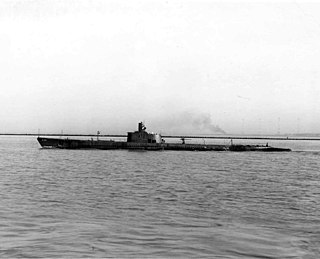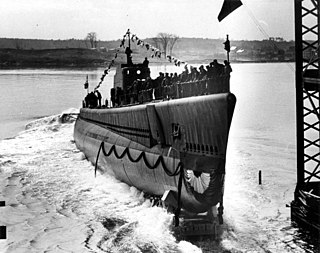
USS Gato (SS-212) was the lead ship of her class of submarine in the United States Navy. She was the first Navy ship named for the common name used for a number of species of catshark. She was commissioned only days after the declaration of war and made thirteen combat patrols during World War II. She survived the war and spent the post-war period as a training ship before being sold for scrapping in 1960.

USS Skate (SS-305) was a Balao-class submarine in service with the United States Navy from 1943 to 1946. She was used as a target ship in the 1946 atomic bomb tests and finally sunk as a target ship in October 1948.

USS Herring (SS-233), a Gato-class submarine, was the only ship of the United States Navy to be named for the herring.

USS Snook (SS-279), a Gato-class submarine, was the first ship of the United States Navy to be named for the common snook, an Atlantic marine fish that is bluish-gray above and silvery below a black lateral line.

USS Flier (SS-250) was a Gato-class submarine, was the only ship of the United States Navy to be named for the flier.

USS Silversides (SS/AGSS-236) is a Gato-class submarine, the first ship of the United States Navy to be named for the silversides.

USS Sand Lance (SS-381), a Balao-class submarine, was the first ship of the United States Navy to be named for the sand lance, a member of the family Ammodytidae.

USS Greenling (SS-213), a Gato-class submarine, was the first ship of the United States Navy to be named for the greenling.

USS Flying Fish (SS/AGSS-229), a Gato-class submarine, was the first submarine and second ship of the United States Navy to be named for the flying fish. Flying Fish is credited with having sunk a total of 58,306 tons of Japanese shipping and received 12 battle stars for World War II service.

USS Haddock (SS-231), a Gato-class submarine, was the second submarine of the United States Navy to be named for the haddock, a small edible Atlantic fish related to the cod. A previous submarine had been named Haddock (SS-32), but was renamed K-1 prior to her launching, so Haddock (SS-231) was the first to actually bear the name.

USS Kingfish (SS-234), a Gato-class submarine, was the first ship of the United States Navy to be named for the kingfish.

USS Jack (SS-259), a Gato-class submarine, was the first ship of the United States Navy to be named for the jack.

USS Muskallunge (SS-262), a Gato-class submarine, was a ship of the United States Navy named for the muskallunge.

USS Peto (SS-265), a Gato-class submarine, was a ship of the United States Navy named for the peto, a sharp-nosed tropical fish of the mackerel family.

USS Pogy (SS-266), a Gato-class submarine, was the first ship of the United States Navy to be named for the pogy, or menhaden. She was credited with sinking 16 ships totaling 62,633 gross register tons during World War II.

USS Puffer (SS-268), a Gato-class submarine, was the first ship of the United States Navy to be named for the puffer.

USS Sawfish (SS-276), a Gato-class submarine, was a ship of the United States Navy named for the sawfish, a viviparous ray which has a long flat snout with a row of toothlike structures along each edge. It is found principally in the mouths of tropical American and African rivers.

The first USS Sunfish (SS-281), a Gato-class submarine, was the first ship of the United States Navy to be named for the ocean sunfish, Mola mola, a plectognath marine fish, having a deep body truncated behind, and high dorsal and anal fins.

USS Seahorse (SS-304), a Balao-class submarine, was the first submarine and second ship of the United States Navy to be named for the seahorse, a small fish whose head and the fore part of its body suggest the head and neck of a horse.

USS Apogon (SS-308), a Balao-class submarine, was a ship of the United States Navy named for the apogons, a genus of cardinalfishes found in tropical and subtropical waters. The original name planned for the ship was Abadejo, but the name was changed on 24 September 1942 before the keel was laid down.




















